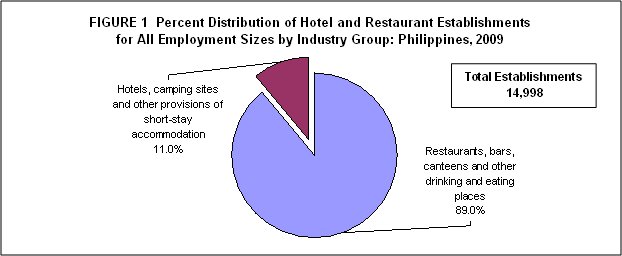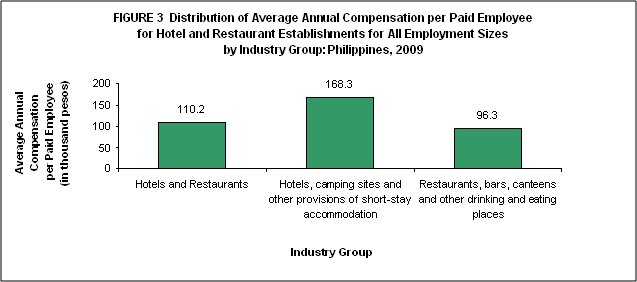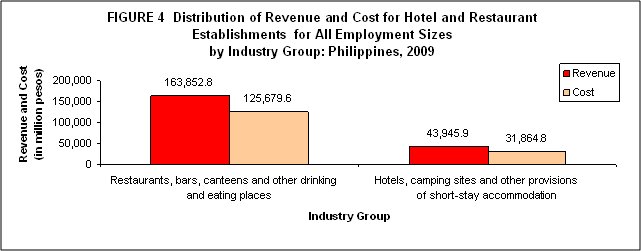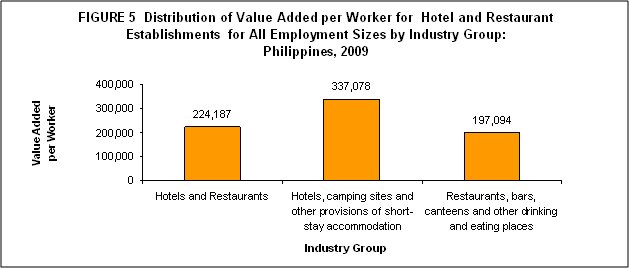Number of Establishments
-
Final results of the 2009 Annual Survey of Philippine Business and Industry (ASPBI) conducted nationwide recorded a total of 14,998 Hotel and Restaurant establishments in the Philippines. As shown in Figure 1, Restaurants, bars, canteens and other drinking and eating places garnered the highest number of establishments at 13,348 or 89.0 percent. Hotels, camping sites and other provisions of short-stay accommodation comprised the remaining number of establishments with 1,650 or 11.0 percent.

Employment
-
Employment in this sector in 2009 numbered 290,672. Of the total employment, 283,171 or 97.4 percent were paid employees and the rest, 7,501 or 2.6 percent, were working owners and unpaid workers.
-
Figure 2 shows that Restaurants, bars, canteens and other drinking places had the most number of employees with 234,413 or 80.6 percent of total employment while establishments engaged in Hotels, camping sites and other provisions of short stay accommodation had 56,259 or 19.4 percent.

-
The average number of workers per establishment was 19. Hotels, camping sites and other provisions of short-stay accommodation had 34 compared to Restaurants, bars, canteens and other eating and drinking places with only 18 average number of workers per establishment.
Compensation
-
Total compensation paid by Hotels and restaurants amounted to PHP31,197.7 million, equivalent to PHP110,173 average annual compensation per employee.
-
By industry group, Restaurants, bars, canteens and other eating and drinking places paid the highest compensation to its employees amounting to PHP22,034.5 million or 70.6 percent of the total compensation higher than those paid by Hotels, camping sites and other provisions of short-stay accommodation at PHP9,163.3 million or 29.4 percent of the total. Average annual compensation for Hotels, camping sites and other provisions of short-stay accommodation was PHP168,254 compared to that of Restaurants, bars, canteens and other eating and drinking places at PHP96,342.

Revenue
-
Revenue earned in 2009 for Hotels and Restaurants sector reached PHP207,798.7 million. Restaurants, bars, canteens and other eating and drinking places were the top contributor with PHP163,852.8 million comprised 78.9 percent of the total revenue. Hotels, camping sites and other provisions of short-stay accommodation generated PHP43,945.9 million or 21.1 percent of the total.
Cost
-
Cost for operating the sector summed up to PHP157,544.4 million. Restaurants, bars, canteens and other eating and drinking places incurred the highest cost with PHP125,679.6 million (79.8 %) of the total cost. Hotels, camping sites and other provisions of short-stay accommodation spent PHP31,864.8 million or 20.2 percent of the total cost.
-
Distribution of revenue and cost by industry group is shown in Figure 4.

Revenue per Cost
-
Revenue per cost ratio, or the revenue generated per one peso cost, for this sector amounted to PHP1.32. Hotels, camping sites and other provisions of short-stay accommodation obtained a PHP1.38 revenue per peso cost. On the other hand, Restaurants, bars, canteens and other eating and drinking places registered a slightly lower revenue per peso cost of PHP1.30.
Value Added
-
Value added for Hotels and restaurants sector was estimated at PHP65,165.0 million. Value added for Restaurants, bars, canteens and other eating and drinking places was recorded at PHP46,201.3 million or 70.9 percent of the value added for the sector, while those of Hotels, camping sites and other provisions of short-stay accommodation was PHP18,963.7 million or 29.1 percent.
Labor Productivity
-
Value added per worker a measure of labor productivity, was valued at an average of PHP224,187 per worker for the whole sector. For this indicator, Hotels, camping sites and other provisions of short-stay accommodation had PHP337,078 while Restaurants, bars, canteens and other eating and drinking places at PHP197,094. (See Figure 5)

Gross Additions to Tangible Fixed Assets
-
Gross additions to tangible fixed assets of this sector in 2009 totaled PHP16,555.8 million. Hotels, camping sites and other provisions of short-stay accommodation recorded PHP11,664.3 million (70.5%) while Restaurants, bars, canteens and other eating and drinking places had PHP4,891.5 million or 29.5 percent.
Change in Inventories
-
Change in inventories, defined as the value of ending inventory less the beginning inventory, amounted to PHP771.9 million in 2009. Restaurants, bars, canteens and other eating and drinking places recorded PHP687.7 million or 89.1 percent, while Hotels, camping sites and other provisions of short-stay accommodation. had PHP84.2 million or 10.9 percent.
TECHNICAL NOTES
Introduction
The 2009 Annual Survey of Philippine Business and Industry (ASPBI), conducted in 2010 with 2009 as reference year, is one of the continuing activities of the National Statistics Office. It will be a source of benchmark levels on the structure and trends of economic activities in the country for the year 2009. Particularly, the data from ASPBI will be used in constructing national and regional income accounts in the country, determining and comparing regional economic structures, and formulating plans and policies of the government in the attainment of economic goals..
The conduct of the ASPBI is governed by legislative acts and presidential directives, specifically Commonwealth Act No. 591 which was approved on August 19, 1940..
Scope and coverage
The 2009 ASPBI covered establishments engaged in 14 economic sectors classified under the Amended 1994 Philippine Standard Industrial classification (PSIC) namely:
-
Agriculture, Hunting and Forestry
-
Fishing
-
Mining and Quarrying
-
Manufacturing
-
Electricity, Gas and Water Supply
-
Construction
-
Wholesale and Retail Trade; Repair of Motor Vehicles, Motorcycles and Personal and Household Goods
-
Hotels and Restaurants
-
Transport, Storage and Communications
-
Financial Intermediation
-
Real Estate, Renting and Business Activities
-
Private Education
-
Health and Social Work
-
Other Community, Social and Personal Service Activities
The scope of the ASPBI was confined to "formal sector" only, which consists of the following:.
-
Corporations and partnership
-
Cooperatives and foundations
-
Single proprietorships with employment of 10 or more
-
Single proprietorships with branches
Like all other establishment surveys conducted by the NSO, the 2009 ASPBI used establishment as the unit of enumeration. It is defined as "an economic unit under a single ownership or control, i.e. under a single legal entity, engaged in one or predominantly one kind of economic activity at a single fixed location."
Classification of Establishments
Before the actual selection of samples, the establishments listed in the frame were classified based on economic organization EO), legal organization (LO), industrial classification, employment size, and geographic location.
Economic organizations relates to the organizational structure or role of the establishment in the organization. The following are the types of economic organization:
-
Single establishment is an establishment which has neither branch nor main office
-
Branch only is an establishment which has a separate main office located elsewhere
-
Establishment and main office, both located in the same address and with branches elsewhere
-
Main office only is the unit which controls, supervises and directs one or more establishments of an enterprise
-
Ancillary unit other than main office is the unit that operates primarily or exclusively for a related establishment or group of related establishments or its parent establishment and provides goods or services that support but do not become part of the output of those establishments
The legal organization provides the legal basis for ownership of the establishment. The following are the types of legal organization:
-
Single Proprietorship refers to a business establishment organized, owned, and managed by one person, who alone assumes the risk of the business enterprise. The establishment name is that of a person, or it has words such as Owner, Proprietor or Operator
-
Partnership refers to an association of two or more individuals for the conduct of a business enterprise based upon an agreement or contract between or among them to contribute money, property or industry into a common fund with the intention of dividing profits among themselves. The establishment name includes words such as Owners , Partners, Limited or LTD., Associates or ASSOCS
-
Government Corporation is a private corporation organized for private aim, benefit or purpose and owned and controlled by the government. The establishment name included words such as Corporation or CORP., INCORPORATED or INC
-
Private Corporation is a corporation organized by private persons. The establishment name includes words such Corporation or Corp, Incorporated or INC
-
Cooperative - the establishment name includes words such as Cooperative or COOP
The industrial classification of an economic unit is determined by the activity from which it derives its major income or revenue. The amended 1994 PSIC is utilized to classify units according to their economic activities.
The amended 1994 PSIC consists of an alpha character and 5 numeric digits. The alpha character, which represents the major division, is denoted by the characters A to Q. The first two numeric digits represent the division; the first three numeric digits, the group; the first four digits, the class; and the 5 digits, the sub-class.
The size of the establishment is determined by its total employment (TE). The following are the employment size classification used in the 2009 ASPBI:
| TE Code | Total Employment | TE Code | Total Employment |
| 0 | 1 - 4 | 5 | 100 - 199 |
| 1 | 5 - 9 | 6 | 200 - 499 |
| 2 | 10 - 19 | 7 | 500 - 999 |
| 3 | 20 - 49 | 8 | 1000 - 1999 |
| 4 | 50 - 99 | 9 | 2000 and Over |
The geographic or physical location of the establishments was classified in accordance with the Philippine Standard Geographic Code (PSGC) as of December 30, 2006 which contains the latest updates on the number of regions, provinces, cities, municipalities and barangays in the Philippines.
The geographic domains of the 2009 ASPBI for establishments with TE of 20 and over are the 17 administrative regions while the whole country serves as the geographic domain for establishments with TE of less than 20.
Hence, the samples of the 2009 ASPBI with TE of 20 and over shall provide data for 17 administrative regions. For samples with TE less than 20, the data that will be presented is limited only at the national level.
Response Rate
A total of 2,893 or 94.4 percent of sample establishments responded. These include receipts of "good" questionnaires, partially accomplished questionnaires, reports of closed, moved out or out of scope establishments.
Concepts and Definition of Terms
Economic activity or business is the activity of the establishment as classified under the amended 1994 Philippine Standard Industrial Classification (PSIC). Generally, the main activity of the establishment is the establishment's principal source of income. If the establishment is engaged in several activities, its main activity is that which earns the biggest income or revenue.
Total employment is the number of persons who worked in or for this establishment as of November 15, 2009.
Paid employees are all persons working in the establishment and receiving pay, as well as those working away from the establishment paid by and under the control of the establishment. Included are all employees on sick leave, paid vacation or holiday. Excluded are consultants, home workers, workers receiving pure commissions only, and workers on indefinite leave.
Salaries and wages are payments in cash or in kind to all employees, prior to deductions for employee's contributions to SSS/GSIS, withholding tax, etc. Included are total basic pay, overtime pay, and other benefits.
Revenue is the value of goods, products/by-products sold and/or services rendered to others whether paid in cash or is considered receivable by the establishment. Valuation of products/by products sold should be in producer's price (ex-establishment), net of discounts and allowances, including duties and charges but excluding subsidies. It also include goods transferred and/or services rendered to other establishment belonging to the same enterprise as the said establishment which should be treated as sales or as if sold to a customer; and revenue from products on a contractual basis from materials supplied by the establishment.
Cost refers to all expenses excluding compensation incurred during the year whether paid or payable. Valuation should be at purchaser's price including taxes and other charges, net of discounts, rebates, returns and allowances. Goods received from and services rendered by other establishment of the same enterprise are valued as though purchased.
Fixed assets are physical assets expected to have productive lives of more than one year and intended for use and/or being used by the establishment. Included are land, buildings, other structures and land improvements, transport equipment, machinery and equipment, furniture, fixtures, and other fixed assets.
Book value of tangible assets is the initial value or acquisition cost of tangible fixed assets less the accumulated depreciation.
Gross additions to fixed assets is the sum of cost of new and used fixed assets acquired during the year, cost of alteration and improvements done by others and cost of fixed assets produced by the establishment less the value of sales of fixed assets during the year.
Value added is gross output less intermediate input. Gross output for hotels and restaurants is the sum of the total revenue (less interest income, rent income from land, dividend income, royalty income and franchise income), capital expenditures of fixed assets produced on own account and change in inventories. Intermediate input is equal to the sum of the following cost items: materials and supplies purchased; fuels, lubricants, oils and greases purchased; electricity and water purchased; cost of industrial services done by others; cost of non-industrial services done by others; goods purchased for resale; research and experimental development expense; environmental protection expense; royalty fee; franchise fee and other cost.
Inventories refer to the stocks of goods owned by and under the control of the establishment as of a fixed date, regardless of where the stocks are located. Valuation should be at current replacement cost in purchaser's price at the indicated dates. Replacement cost is the cost of an item in terms of its present price rather than its original price.
Change in inventories is equivalent to the total value of inventories at the end of the year less the value at the beginning of the year.
Subsidies are special grants in the form of financial assistance or tax exemption or tax privilege given by the government to aid and develop an industry or production and to protect it against competition.
Source; National Statistics Office
Manila, Philippines
